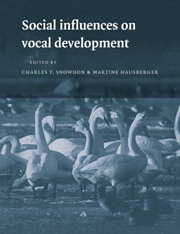Book contents
- Frontmatter
- Contents
- List of contributor
- 1 Introduction
- 2 Social interaction and sensitive phases for song learning: A critical review
- 3 Social interaction and vocal development in birds
- 4 Building a social agenda for the study of bird song
- 5 Field observations, experimental design, and the time and place of learning bird songs
- 6 Vocal learning in wild and domesticated zebra finches: Signature cues for kin recognition or epiphenomena?
- 7 What birds with complex social relationships can tell us about vocal learning: Vocal sharing in avian groups
- 8 Social influences on song acquisition and sharing in the European starling (Sturnus vulgaris)
- 9 Social influences on the acquisition of human-based codes in parrots and nonhuman primates
- 10 Vocal learning in captive bottlenose dolphins: A comparison with humans and nonhuman animals
- 11 Vocal learning in cetaceans
- 12 Social influences on vocal development in New World primates
- 13 Some general features of vocal development in nonhuman primates
- 14 Social influences on vocal learning in human and nonhuman primates
- 15 The resilience of language in humans
- 16 Reciprocal interactions and the development of communication and language between parents and children
- 17 Crafting activities: Building social organization through language in girls' and boys' groups
- Index
11 - Vocal learning in cetaceans
Published online by Cambridge University Press: 04 August 2010
- Frontmatter
- Contents
- List of contributor
- 1 Introduction
- 2 Social interaction and sensitive phases for song learning: A critical review
- 3 Social interaction and vocal development in birds
- 4 Building a social agenda for the study of bird song
- 5 Field observations, experimental design, and the time and place of learning bird songs
- 6 Vocal learning in wild and domesticated zebra finches: Signature cues for kin recognition or epiphenomena?
- 7 What birds with complex social relationships can tell us about vocal learning: Vocal sharing in avian groups
- 8 Social influences on song acquisition and sharing in the European starling (Sturnus vulgaris)
- 9 Social influences on the acquisition of human-based codes in parrots and nonhuman primates
- 10 Vocal learning in captive bottlenose dolphins: A comparison with humans and nonhuman animals
- 11 Vocal learning in cetaceans
- 12 Social influences on vocal development in New World primates
- 13 Some general features of vocal development in nonhuman primates
- 14 Social influences on vocal learning in human and nonhuman primates
- 15 The resilience of language in humans
- 16 Reciprocal interactions and the development of communication and language between parents and children
- 17 Crafting activities: Building social organization through language in girls' and boys' groups
- Index
Summary
INTRODUCTION
Marine mammals stand out among nonhuman mammals in their abilities to modify their vocalizations on the basis of auditory experience. While there is good evidence that terrestrial mammals learn to comprehend and use their calls correctly, there is much less evidence for modification of vocal production (Seyfarth & Cheney, Chapter 13). In contrast, vocal learning has evolved independently in at least two marine mammal taxa, the seals and cetaceans, and is widespread among the whales and dolphins. We concentrate our focus in this chapter on vocal learning and development in the bottlenose dolphin (Tursiops truncatus) because it is the marine mammal species in which vocal learning and imitation has been best studied.
Dolphins produce a variety of sounds. The two predominant sound types are clicks, which can be used for echolocation, and frequency-modulated whistles, which are used for social communication. In addition to whistles, dolphins produce short frequency upsweeps that have been called chirps (Caldwell & Caldwell 1970). The dolphin vocal repertoire also includes a variety of burst pulsed sounds and combinations of pulses and whistles.
Captive bottlenose dolphins of both sexes are highly skilled at imitating synthetic pulsed sounds and whistles (Caldwell & Caldwell 1972; Herman 1980). Once a dolphin learns to copy a sound, the novel sound can be incorporated into its vocal repertoire, and the dolphin can produce the sound even when it does not hear the model. Bottlenose dolphins may imitate sounds spontaneously within a few seconds after the first exposure (Herman 1980), or after only a few exposures (Reiss & McCowan 1993).
- Type
- Chapter
- Information
- Social Influences on Vocal Development , pp. 208 - 233Publisher: Cambridge University PressPrint publication year: 1997
- 58
- Cited by



